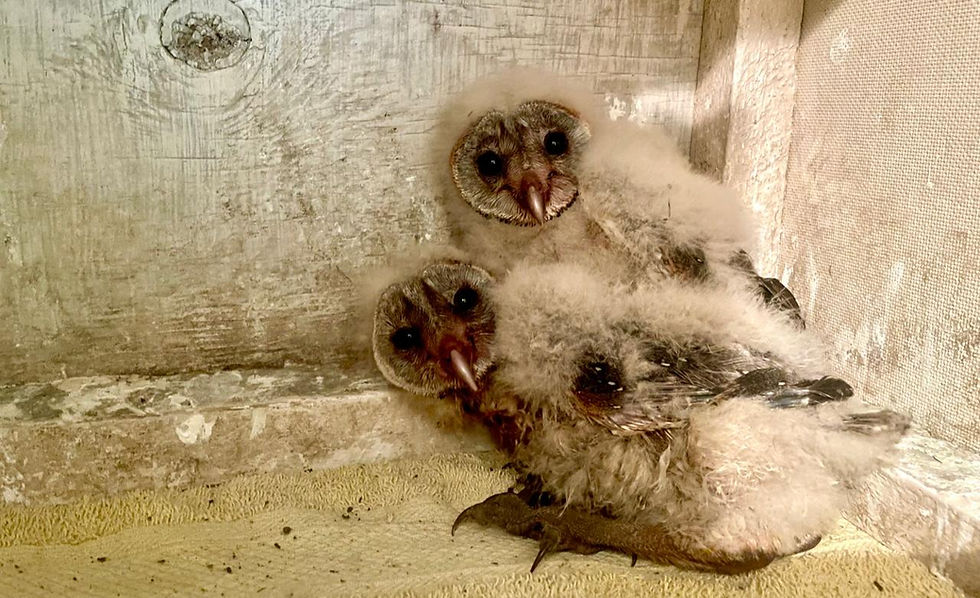Fun and fascinating facts about the avian eye
- Simon Thomsett

- Aug 30, 2021
- 3 min read
Raptors have some of the most acute vision known to all animals. The eyes are relatively massive and clearly the most important sense of all. Much of their biology, behaviour and hunting strategies depend wholly upon eyesight. Owls too have incredible vision though experiments have proved that Barn Owls can successfully hunt mice in absolute darkness by hearing alone. Here are some fascinating facts about the avian eye.

Raptors see "off spectrum"
Diurnal raptors see colour better than we do and there is evidence of being able to see “off spectrum” light invisible to us such as ultraviolet and infra-red. Urine trails of rodents are the classic example, variously proved and disproved, that can lead a kestrel to hover overhead explaining how, in the absence of mice, they can detect their presence. Warm currents of air in thermals can be “seen” by hawks who will fly towards them to rise, before they are detectable by humans.

Birds see colours invisible to humans
Cones come in different flavours depending on which pigment they contain, different pigments detect different colours. Humans have 3 pigments: red, green and blue. Birds have 5 pigments which gives them greater sensitivity to certain colours, allowing them to see more different shades of some colours, such as red than we can.
Raptors have excellent image processing software
The retina of raptors, like ours, is covered with light reception cells. Colour receptors are called cones and light preceptors are called rods.
Nocturnal raptors
Owls have very few to no cones so, like many nocturnal animals, they do not see colour. But they have many rods and see light at a luminance value far below that of a human or even a cat, meaning they have excellent night vision.
Diurnal raptors
Diurnal raptors like the Augur Buzzard have about 2-3 times more colour and light receptors on the retina than humans. Like us they have areas where the concentration of receptors is very dense, called a fovea. Humans have one central fovea, most diurnal raptors have two and can be 9-15 times greater than our central fovea. The image quality comparison can be likened to us seeing a 500kb image and them seeing a 5MB image. They have better “software” to process the image and see much more detail.

No burn-out images and glare
Birds have a pecten, a spongy comb-like protuberance on the retina that is highly vascularised. It provides oxygen to the surface of the retina…which in mammals almost works anaerobically. It appears to obscure vision to some part of the retina but this is overcome by the brain. This means birds can instantly see a flash and instantly not see it. We on the other hand continue to “see” a flash well after it is over. Having more oxygen provided by the pecten means the cones and rods are more sensitive and able to remove this burn-out image.
The cones and rods also have a mechanism that can push a red lipid to the front to protect the cells from direct sunlight. It is thought that these can mask highlights for example, allowing a raptor to shield its eye from glare and see beyond it.
Massive eyeballs
As eyesight is the most important sense of a raptor, it comes as no surprise that they have enormous eyes. To compare, if humans had similar sized eyes as eagles, they would be about the size of a big orange. The eyeballs actually meet in the middle and do not leave too much room for the brain.

Limited eye movement
The eyes of birds don’t move more than a few degrees in its socket. It cannot because of its size and dish shape. The neck is much more flexible and allows for tracking objects, shown below by Phil, a rescued Verreaux's Eagle-owl at Naivasha Raptor Centre.
Eye bones
The fore part of a raptor's eye is encircled around the rim of the iris by a sclerotic ring, a series of overlapping bony plates that protect the eye. It also has muscles that can change the focal length.

Eye position
Raptors have forward facing eyes which provide 'binocular' vision which means the eyes have overlapping fields of view, allowing them to see a three-dimensional image and gauging distances very well. This ability is essential for them to effectively hunt and catch prey.

Wish to learn more, visit our website and join us on Facebook and Instagram.
Kenya Bird of Prey Trust
Understand - Protect - Restore






Comments